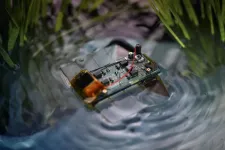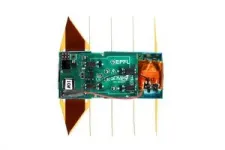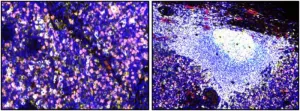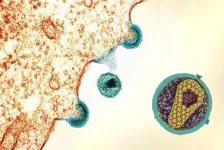A miniature swimming robot inspired by marine flatworms
EPFL engineers have developed a versatile swimming robot that nimbly navigates cluttered water surfaces. Inspired by marine flatworms, the innovative device offers new possibilities for environmental monitoring and ecological research.
2025-02-19
(Press-News.org) Swimming robots play a crucial role in mapping pollution, studying aquatic ecosystems, and monitoring water quality in sensitive areas such as coral reefs or lake shores. However, many devices rely on noisy propellers, which can disturb or harm wildlife. The natural clutter in these environments – including plants, animals, and debris – also poses a challenge to robotic swimmers.
Now, researchers in the Soft Transducers Lab and the Unsteady flow diagnostics laboratory in EPFL’s School of Engineering, and at the Max Planck Institute for Intelligent Systems, have developed a compact and versatile robot that can maneuver through tight spaces and transport payloads much heavier than itself. Smaller than a credit card and weighing 6 grams, the nimble swimming robot is ideal for environments with limited space like rice fields, or for performing inspections in waterborne machines. The research has been published in Science Robotics.
“In 2020, our team demonstrated autonomous insect-scale crawling robots, but making untethered ultra-thin robots for aquatic environments is a whole new challenge,” says EPFL Soft Transducers Lab head Herbert Shea. “We had to start from scratch, developing more powerful soft actuators, new undulating locomotion strategies, and compact high-voltage electronics”.
Miniature electronics for autonomous operation
Unlike traditional propeller-based systems, the EPFL robot uses silently undulating fins –inspired by marine flatworms – for propulsion. This design, combined with its light weight, allows the robot to float on the water’s surface and blend seamlessly into natural environments.
“Our design doesn’t simply replicate nature; it goes beyond what natural organisms can achieve,” explains former EPFL researcher Florian Hartmann, now a research group leader at the Max Planck Institute for Intelligent Systems in Stuttgart, Germany.
By oscillating its fins up to 10 times faster than marine flatworms, the robot can reach impressive speeds of 12 centimeters (2.6 body-lengths) per second. The robot also achieves unprecedented maneuverability by using four artificial muscles to drive the fins. In addition to forward swimming and turning, it is capable of controlled backward and sideways swimming.
To drive the robot, the researchers developed a compact electronic control system that delivers up to 500 volts to the robot’s actuators at a low power of 500 milliwatts – four times less than that of an electric toothbrush. Despite its use of high voltage, the robot’s low currents and shielded circuitry make it entirely safe for its environment. Light sensors act as simple eyes, allowing the robot to detect and follow light sources autonomously.
The researchers envision the robot contributing to ecological studies, pollution tracking, and precision agriculture, amongst other fields. Next steps involve creating a more robust platform for field tests.
“We aim to extend operating times and enhance autonomy,” says Hartmann. “The fundamental insights gained from this project will not only advance the science of bioinspired robotics but also lay the foundation for practical, lifelike robotic systems that harmonize with nature.”
END
ELSE PRESS RELEASES FROM THIS DATE:
2025-02-19
The successful development of sustainable georesources for the energy transition is a key challenge for humankind in the 21st century. Hydrogen gas (H2) has great potential to replace current fossil fuels while simultaneously eliminating the associated emission of CO2 and other pollutants. However, a major obstacle is that H2 must be produced first. Current synthetic hydrogen production is at best based on renewable energies but it can also be polluting if fossil energy is used.
The solution may be found ...
2025-02-19
University of Pittsburgh School of Medicine and UPMC Hillman Cancer Center scientists have discovered a novel subset of cancer-fighting immune cells that reside outside of their normal neighborhood – known as the tertiary lymphoid structure – where they become frustratingly dysfunctional when in close contact with tumors.
Described today in the journal Science Translational Medicine, the finding gives oncologists a new target for developing immunotherapies: double negative memory B cells, so-called because they are negative for two markers found on the surface of their more common brethren. They may also be a useful diagnostic ...
2025-02-19
Groundbreaking research published today in the Journal of Vertebrate Paleontology has unveiled a landmark discovery – fossils of the world’s oldest known megaraptorid and the first evidence of carcharodontosaurs in Australia. These finds rewrite the evolutionary history of theropod dinosaurs, uncovering a predator hierarchy unique to Cretaceous Australia.
The research, led by Museums Victoria Research Institute and Monash University PhD student Jake Kotevski, describes five theropod fossils discovered along Victoria’s coastline. The fossils were unearthed in the upper Strzelecki Group (Bunurong/Boonwurrung ...
2025-02-19
Study Title: Window of opportunity trial reveals mechanisms of response and resistance to navtemadlin in patients with recurrent glioblastoma
Publication: Science Translational Medicine
Dana-Farber Cancer Institute authors: Veronica Rendo, PhD, Eudocia Q. Lee, MD, MPH, Veronica Rendo, PhD Patrick Y. Wen, MD, Keith L. Ligon, MD, PhD, Rameen Beroukhim, MD, PhD
Summary: Clinical research by Dana-Farber scientists suggests that combining a novel agent called navtemadlin with DNA-damaging chemotherapy for the treatment of glioblastoma, a form of brain cancer, could increase efficacy. Navtemadlin ...
2025-02-19
Boston - Kimberly Stegmaier, MD, was named Chair of Pediatric Oncology at Dana-Farber Cancer Institute and Associate Chief of the Division of Hematology/Oncology at Boston Children’s Hospital, in an announcement made today. Her appointment is effective April 1, 2025.
Stegmaier, a Dana-Farber, Boston Children’s Hospital, and Harvard Medical School faculty member since 2002, Stegmaier is currently Vice Chair for Pediatric Oncology Research at Dana-Farber, Co-Director of the Pediatric Hematologic Malignancy Program at Dana-Farber and Boston Children’s Hospital, Co-Leader for the Dana-Farber/Harvard Cancer Center Leukemia Program, and a Professor ...
2025-02-19
NEW YORK – The Human Immunome Project (HIP) and Michelson Medical Research Foundation (MMRF) have awarded Dr. Omar Abudayyeh (Brigham and Women’s Hospital; Harvard Medical School), Dr. Caleb Lareau (Memorial Sloan Kettering Cancer Center), and Dr. Yuzhong Liu (Scripps Research) the 2024 Michelson Prizes: Next Generation Grants.
The $150,000 research grants are awarded annually to support early-career scientists advancing human immunology, vaccine discovery, and immunotherapy research for major global diseases.
“Investing in bold, early-career scientists fuels the high-risk, high-reward ideas ...
2025-02-19
After a year of weather extremes that brought everything from deadly floods to bitter cold, experts at East Tennessee State University have released a detailed analysis of the region’s 2024 weather patterns.
Their findings highlight both record-breaking temperatures and catastrophic storms – underscoring the growing need for preparedness as communities face unpredictable conditions.
The report, published by Tennessee’s Climate Office housed at ETSU, details how Southern Appalachia endured scorching heat and devastating floods, including the tragic September storm linked to ...
2025-02-19
Humans have appreciated the beauty of flowers for centuries. Yet, flowers aren’t just aesthetically pleasing. They also play a crucial role in plant reproduction. In all plants, a well-studied gene with a curious name, Unusual Floral Organs (UFO), orchestrates the flowering process. UFO expression hinges on another complex process called cis-regulation. And this one has remained a “black box” of plant biology research for years.
Now, using CRISPR gene editing, Cold ...
2025-02-19
PHILADELPHIA – Cancer patients spend a lot of time on their care. Meeting with doctors and other members of their health care team, getting labs and other tests, picking up prescriptions, and undergoing treatment all takes time. So does getting to and from each appointment, sitting in the waiting room between each appointment, and so on.
In recent years, cancer researchers have worked to quantify the level of “time toxicity” or time spent commuting to, waiting for, and receiving cancer treatment. Now, for the first time, a pilot study has shown it’s possible to use digital technology to safely ...
2025-02-19
A multi-national, multi-institutional study led by Weill Cornell Medicine investigators found little natural resistance to a new HIV therapy called lenacapavir in a population of patients in Uganda.
The study, published Jan. 30 in the Journal of Antimicrobial Chemotherapy, adds to growing evidence that lenacapavir may be a powerful new tool in the global anti-HIV drug arsenal. Approximately, 1.5 million people are living with HIV in Uganda.
“Our data shows that only 1.6% of the individuals studied are living with HIV ...
LAST 30 PRESS RELEASES:
[Press-News.org] A miniature swimming robot inspired by marine flatworms
EPFL engineers have developed a versatile swimming robot that nimbly navigates cluttered water surfaces. Inspired by marine flatworms, the innovative device offers new possibilities for environmental monitoring and ecological research.









